Tattu vs Graphene LiPo Battery Performance Tests
Jul 7th 2016
The article outlines the Tattu vs Graphene lipo battery testing procedures we used to come up with our results and presents the raw data gathered. Be sure to check out the actual results in our comparison article which will be released next week!
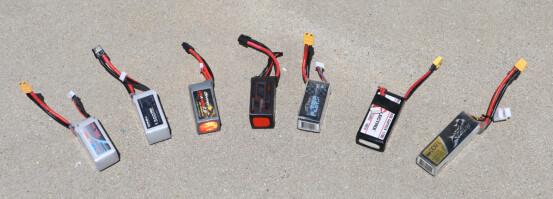 There were five 1300mAh batteries on the block for this comparison test. Dinogy sent us their new Graphene 2.0 packs and Tattu sent us a pre-release version of their upcoming "Top Pilot" series of batteries. We also obtained a Turnigy Graphene pack and a Bonka Graphene pack for comparison as well. Finally, we have a normal Bonka 1300 75C pack to compare the new packs against.
Revolectrix sent us a very early version of their 1700mAh LiHV "GOPack" . I really wanted to include this pack in the test but struggled on how to do it - none of the other batteries were this big nor were they HV. In the end, I decided to test this battery charged to standard LiPo voltages (that's 4.2V per cell) and included a standard Tattu 1800mAh 75C battery in the test to compare against. As a result, this isn't a really fair test for the Revolectrix. I wouldn't use these results to compare it to any of the other batteries but I do find them interesting. I'm eager to get my hands on one of their 1350 regular packs.
There were five 1300mAh batteries on the block for this comparison test. Dinogy sent us their new Graphene 2.0 packs and Tattu sent us a pre-release version of their upcoming "Top Pilot" series of batteries. We also obtained a Turnigy Graphene pack and a Bonka Graphene pack for comparison as well. Finally, we have a normal Bonka 1300 75C pack to compare the new packs against.
Revolectrix sent us a very early version of their 1700mAh LiHV "GOPack" . I really wanted to include this pack in the test but struggled on how to do it - none of the other batteries were this big nor were they HV. In the end, I decided to test this battery charged to standard LiPo voltages (that's 4.2V per cell) and included a standard Tattu 1800mAh 75C battery in the test to compare against. As a result, this isn't a really fair test for the Revolectrix. I wouldn't use these results to compare it to any of the other batteries but I do find them interesting. I'm eager to get my hands on one of their 1350 regular packs.
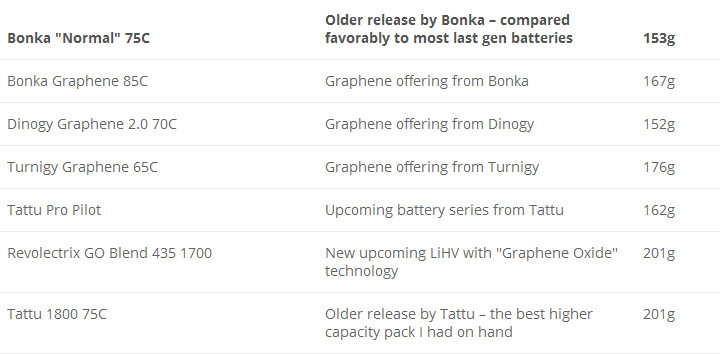 For more information on these batteries, check out our comparison article, which will be linked at the top of this article when it is released.
For more information on these batteries, check out our comparison article, which will be linked at the top of this article when it is released.
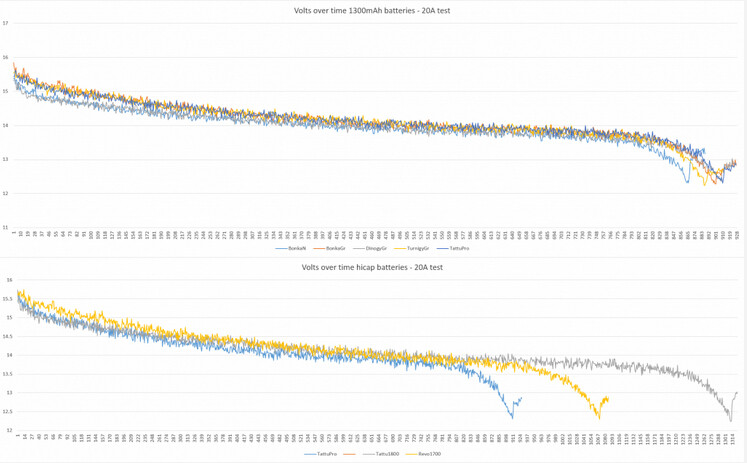 Time field is 1/5th a second.
Time field is 1/5th a second.
 Temperature: Measured after discharge, hottest point on battery.
Charge: Amount of charge put back into battery after test.
Cell Variance: Difference between highest cell voltage and lowest in battery.
All of the 1300mAh batteries were very well matched in terms of capacity. In terms of actual performance, the Dinogy and the "normal" Bonka held about .3V less than the other packs throughout the first half of the test, after which all of the packs were pretty much equal. All of the batteries held their voltage quite well up until they were almost entirely discharged - I was actually pretty surprised by how close this was. All of the packs other than the Turnigy Graphene got pretty hot near the end of this test. Definitely hotter than I am normally comfortable with. I was actually really surprised when I plugged the batteries into the cell balancer to find the opposite indication, though - the Graphene lipo battery was way out of spec and the rest of the batteries were pretty well matched. I guess with the lower price on the Turnigy Graphene you do not get as precise of a cell matching.
I graphed the Tattu 1800 70C and Revolectrix GO pack separately to not obscure the 1300mAh graph. In this chart I included the Tattu top Pilot as well for comparison against 1300 packs. Keep in mind that since the Revolectrix is a HV pack, it was not charged to it's full capacity. Given that, I think it actually did quite well - managing to keep putting out consistent current all the way down to 12.8V - it actually seems to perform like a regular LiPo throughout the discharge curve, whereas I expected it to drop off somewhere in the 13V range.
Temperature: Measured after discharge, hottest point on battery.
Charge: Amount of charge put back into battery after test.
Cell Variance: Difference between highest cell voltage and lowest in battery.
All of the 1300mAh batteries were very well matched in terms of capacity. In terms of actual performance, the Dinogy and the "normal" Bonka held about .3V less than the other packs throughout the first half of the test, after which all of the packs were pretty much equal. All of the batteries held their voltage quite well up until they were almost entirely discharged - I was actually pretty surprised by how close this was. All of the packs other than the Turnigy Graphene got pretty hot near the end of this test. Definitely hotter than I am normally comfortable with. I was actually really surprised when I plugged the batteries into the cell balancer to find the opposite indication, though - the Graphene lipo battery was way out of spec and the rest of the batteries were pretty well matched. I guess with the lower price on the Turnigy Graphene you do not get as precise of a cell matching.
I graphed the Tattu 1800 70C and Revolectrix GO pack separately to not obscure the 1300mAh graph. In this chart I included the Tattu top Pilot as well for comparison against 1300 packs. Keep in mind that since the Revolectrix is a HV pack, it was not charged to it's full capacity. Given that, I think it actually did quite well - managing to keep putting out consistent current all the way down to 12.8V - it actually seems to perform like a regular LiPo throughout the discharge curve, whereas I expected it to drop off somewhere in the 13V range.
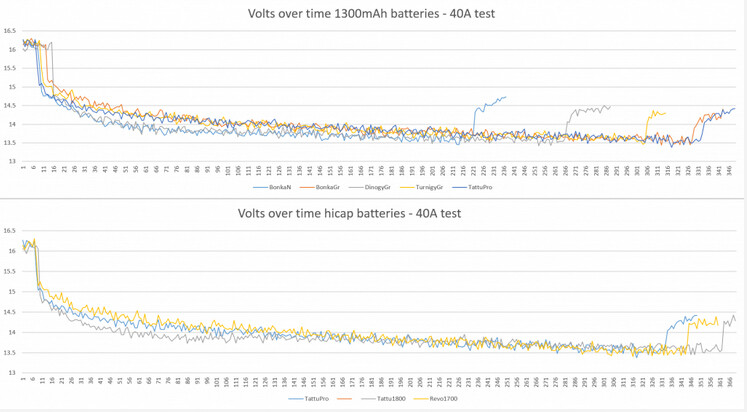 Time field is 1/5th a second.
Time field is 1/5th a second.
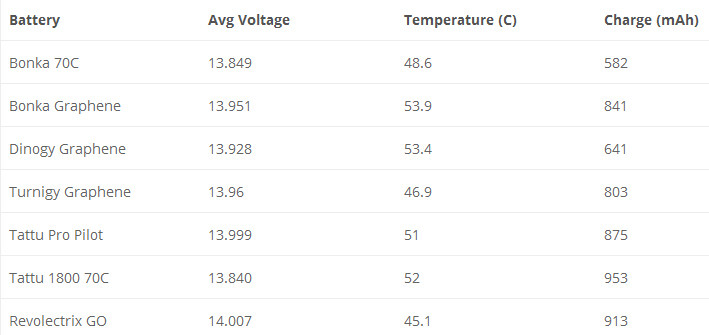 Cell variance was not performed on this test as all cells were matched on all batteries.
Voltage was only averaged when?load was applied.
I think this test is the most indicative of what these packs would experience while racing on a wide, open course. It's also where the benefits of whatever technology that's in them starts to show. Every one of the new battery packs kicked the ass of the "older" Bonka 70C by a large margin in every measureable way. What's more amazing to me is that all of the new generation of packs were able to perform close to, or better than the Tattu 1800 70C - that's amazing! It's basically saying that these new packs can deliver to you the performance of a 1800mAh pack in a 1300mAh pack and weight. They all discharged over half of their capacity (actually - past where I would normally cut off when flying - which is normally 800mAh for 1300 packs) at 40A. That's pretty damned incredible.
The 1300s all performed pretty similar, again. The Dinogy once again held the same voltage as the Bonka 70C at the low end - albeit significantly longer before dropping off - and the other packs held a higher voltage through the entire test. Voltage of most of pack was always within swinging distance of each other, with the average voltage over the test not varying by more than .07V between the lowest and highest packs. The Turnigy Graphene pack again came down noticeably cooler than the other packs. Maybe that's because of the extra weight
The Revolectrix pack again showed the best voltage holding capabilities - staying noticeably higher through the entire test and delivering the highest average of all the packs. When it comes to power delivery, this is a damned impressive pack - but once again I can't say how much of that is because it's a LiHV in sheeps clothing.
Cell variance was not performed on this test as all cells were matched on all batteries.
Voltage was only averaged when?load was applied.
I think this test is the most indicative of what these packs would experience while racing on a wide, open course. It's also where the benefits of whatever technology that's in them starts to show. Every one of the new battery packs kicked the ass of the "older" Bonka 70C by a large margin in every measureable way. What's more amazing to me is that all of the new generation of packs were able to perform close to, or better than the Tattu 1800 70C - that's amazing! It's basically saying that these new packs can deliver to you the performance of a 1800mAh pack in a 1300mAh pack and weight. They all discharged over half of their capacity (actually - past where I would normally cut off when flying - which is normally 800mAh for 1300 packs) at 40A. That's pretty damned incredible.
The 1300s all performed pretty similar, again. The Dinogy once again held the same voltage as the Bonka 70C at the low end - albeit significantly longer before dropping off - and the other packs held a higher voltage through the entire test. Voltage of most of pack was always within swinging distance of each other, with the average voltage over the test not varying by more than .07V between the lowest and highest packs. The Turnigy Graphene pack again came down noticeably cooler than the other packs. Maybe that's because of the extra weight
The Revolectrix pack again showed the best voltage holding capabilities - staying noticeably higher through the entire test and delivering the highest average of all the packs. When it comes to power delivery, this is a damned impressive pack - but once again I can't say how much of that is because it's a LiHV in sheeps clothing.
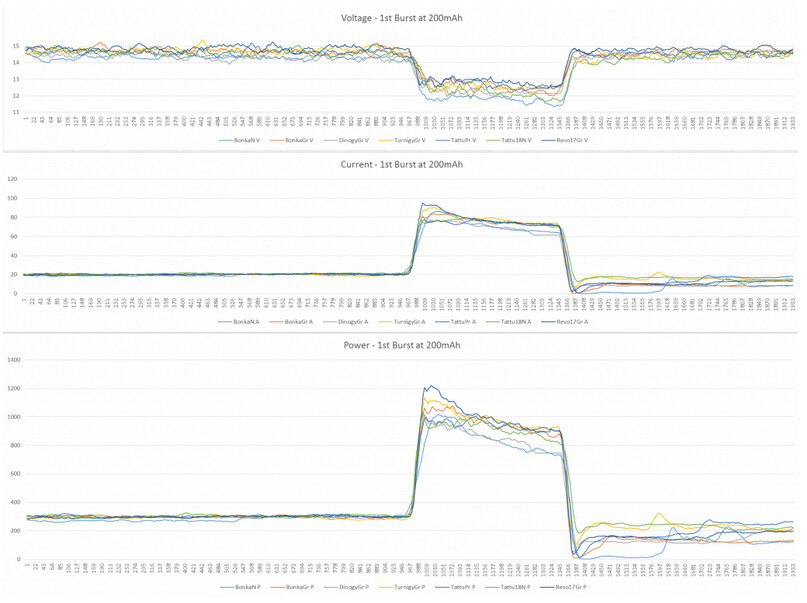
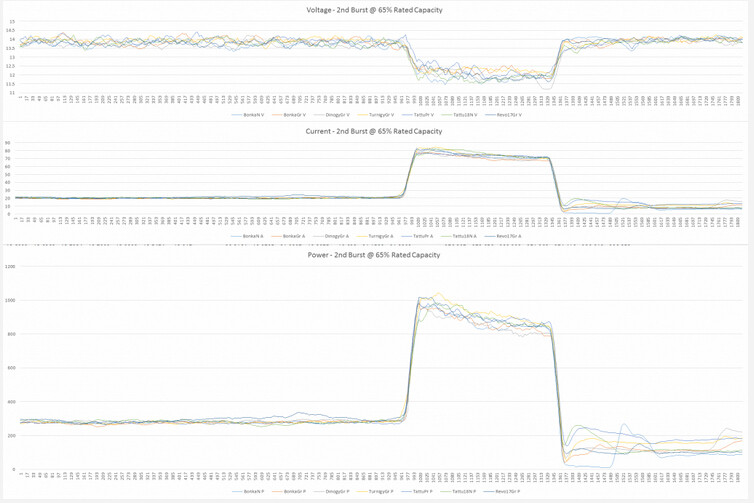 Time field is 1/125th of a second.
Time field is 1/125th of a second.
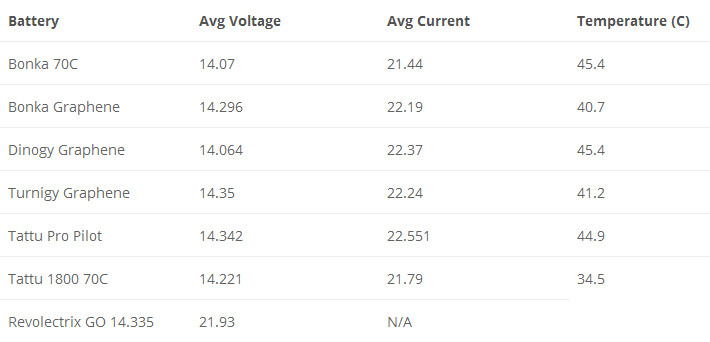 Average voltage and current measured from the start of 20A current draw until the end of the last burst.
Temperature measured 30 seconds after landing. Missing Revolectrix data - it was lost.
Keep in mind that during this test, the batteries are not the limiting factor - it was the power system. All of the batteries in the test were more than willing to give the 80A requested by the motors in the initial climb. They then all performed similarly through both of the climbs with a large initial voltage drop-off followed by relative stability. Power decreased as the miniquad accelerated through the air and the props unloaded. Variations in the air density during the climb or angular changes in the quad can easily account for any of the variance seen in these tests.
Of note is that other than the Dinogy pack, the newer packs all held about .3V more than the "old" Bonka 70C on average throughout the entire test. They also once again trumped the Tattu 1800mAh on voltage holding capability as well. This seems to be the running theme of the test - all of these packs hold their voltage better under load when compared with my "older" reference packs.
I had seen a lot of people talk about how inductive loads (basically - loads that fluctuate rapidly with time due to the PWM motor drivers we use on our brushless motors) affect batteries differently than resistive loads. From the results in this test, I didn't really see any difference between these types of loads. Perhaps I was not stressing the batteries enough.
I'm really interested to see how these perform with better motors.
Average voltage and current measured from the start of 20A current draw until the end of the last burst.
Temperature measured 30 seconds after landing. Missing Revolectrix data - it was lost.
Keep in mind that during this test, the batteries are not the limiting factor - it was the power system. All of the batteries in the test were more than willing to give the 80A requested by the motors in the initial climb. They then all performed similarly through both of the climbs with a large initial voltage drop-off followed by relative stability. Power decreased as the miniquad accelerated through the air and the props unloaded. Variations in the air density during the climb or angular changes in the quad can easily account for any of the variance seen in these tests.
Of note is that other than the Dinogy pack, the newer packs all held about .3V more than the "old" Bonka 70C on average throughout the entire test. They also once again trumped the Tattu 1800mAh on voltage holding capability as well. This seems to be the running theme of the test - all of these packs hold their voltage better under load when compared with my "older" reference packs.
I had seen a lot of people talk about how inductive loads (basically - loads that fluctuate rapidly with time due to the PWM motor drivers we use on our brushless motors) affect batteries differently than resistive loads. From the results in this test, I didn't really see any difference between these types of loads. Perhaps I was not stressing the batteries enough.
I'm really interested to see how these perform with better motors.
Graphene lipo battery Background
After Bonka announced that they were entering the "graphene" market behind Turnigy, I knew I wanted to do a comparison test pitting "graphene" batteries against each other and their predecessors. After contacting several battery manufacturers, I learned that pretty much everyone was poised to introduce a new range of battery packs, most of which are labeled "graphene". I was excited about the prospect of comparing these "graphene" packs in total against a top-contender of the "last generation" of batteries.What is the Graphene?
A little background on graphene. First of all - what it is is a sheet of carbon atoms, aligned in a 2-dimensional crystalline pattern. When it's synthesis and handling is perfected, it could feasibly be used in the electrodes of the battery to thin the chemical layers that make up the battery and significantly improve both capacity and power. There is also research going into what is called "lithium sulfur" batteries, which use graphene as an integral component to make similar leaps in performance over traditional lithium batteries. One thing is certain, though - these batteries do have something different going on with them. As you will soon see, they all have performance figures that are eerily similar to each other, and all differ from the "older" style LiPo I threw into the test.The battery Tests
I performed 3 tests on these sets of batteries, outlined below.20A Constant Discharge Test
The first test was a constant discharge to 12.8V indicated (3.2V/cell under load). The intent of this test was mainly to see the capacity of each battery. The load I selected was 20A - which is very close to my average flight load when I am not racing. I hooked the battery up to my load cell, a volt meter and my data recorder and let the battery discharge until the voltmeter read 12.8V. I chose 12.8V because it is well into the sharp voltage drop off point of every battery in this test but not so low as to seriously damage the batteries - they all jumped back up to 3.5-3.6V / cell when the load was released. After the batteries were done with the test, they were set aside for 30 seconds and then had their temperature measured. After that, I measured the balance of the pack, recording the voltage difference between the lowest cell and the top cell. Generally, when battery cells are mismatched, it is because they have a slightly different capacity than their mates - since this test is all about totally discharging the battery it is a perfect time to check that. Finally, the batteries were charged back up to full and the amount of charge put back into them was recorded.40A Stress Test
The second test was a constant discharge to 14V indicated with a load of 40A. The stop point of 14V in this test is well before the batteries fully discharge - the intent was to see how much charge the batteries could push through while holding a decent voltage under high load. 40A is a pretty typical load when racing so I think this test is a good indicator what batteries will hold up well for that purpose. Once the batteries hit 14V, they rested for 30 seconds and their temperature was measured. Finally, they were once again charged back to full and the charge put in was recorded.Flight Test
The final test was an in-flight test where the battery metrics were recorded with Blackbox. The purpose of this test was to show how the batteries performed when the pilot does bursts of full throttle during an otherwise constant load. Here is the procedure I followed: 1.Take off, fly in a circle using the OSD to keep a constant 20A discharge rate. 2.At 200mAh indicated consumption (on the OSD) do a full throttle pull-out for 3-5 seconds. 3.Descend quickly. 4.Continue flying at 20A in a circle until 700mAh indicated consumption, or 55% of the labeled capacity for the bigger batteries. 5.Do a full throttle pullout for another 3-5 seconds. 6.Descend and land.What I wanted to see in this test was:
1.How much effect different batteries have on the amount of power available in a climbout. 2.How each battery handled a full power climbout when it was near-fully charged vs when it was close to being depleted. 3.How much voltage sag each battery experienced in a climbout and how quickly it recovered. 4.How an inductive load on the batteries differed from a resistive load. Again - the original intent of this test was to use some of the ridiculous new N52 motors to really put the fear of god into these batteries. Unfortunately that could not happen for this test because the motors I am using are out of stock and I don't have the funds to change out all of my motors. I intend to re-test this when I get some new ZMX v2s.Disclaimer
I wouldn't recommend anyone treat their batteries like I did in these tests. The in-flight testing is probably fine but batteries in this size really did not like the 20A full discharge and 40A stress test. Most of them got quite hot, especially nearing the end of the 20A test, and one even puffed slightly. Unless you like replacing batteries frequently, I don't recommend ever discharging below 14V indicated on a 4S pack- your batteries are telling you that they cannot handle the discharge and you should listen. When LiPos are stressed like this, their internals undergo chemical changes which permanently affects their capacity and power delivery capabilities.The Battery Lineup
 There were five 1300mAh batteries on the block for this comparison test. Dinogy sent us their new Graphene 2.0 packs and Tattu sent us a pre-release version of their upcoming "Top Pilot" series of batteries. We also obtained a Turnigy Graphene pack and a Bonka Graphene pack for comparison as well. Finally, we have a normal Bonka 1300 75C pack to compare the new packs against.
Revolectrix sent us a very early version of their 1700mAh LiHV "GOPack" . I really wanted to include this pack in the test but struggled on how to do it - none of the other batteries were this big nor were they HV. In the end, I decided to test this battery charged to standard LiPo voltages (that's 4.2V per cell) and included a standard Tattu 1800mAh 75C battery in the test to compare against. As a result, this isn't a really fair test for the Revolectrix. I wouldn't use these results to compare it to any of the other batteries but I do find them interesting. I'm eager to get my hands on one of their 1350 regular packs.
There were five 1300mAh batteries on the block for this comparison test. Dinogy sent us their new Graphene 2.0 packs and Tattu sent us a pre-release version of their upcoming "Top Pilot" series of batteries. We also obtained a Turnigy Graphene pack and a Bonka Graphene pack for comparison as well. Finally, we have a normal Bonka 1300 75C pack to compare the new packs against.
Revolectrix sent us a very early version of their 1700mAh LiHV "GOPack" . I really wanted to include this pack in the test but struggled on how to do it - none of the other batteries were this big nor were they HV. In the end, I decided to test this battery charged to standard LiPo voltages (that's 4.2V per cell) and included a standard Tattu 1800mAh 75C battery in the test to compare against. As a result, this isn't a really fair test for the Revolectrix. I wouldn't use these results to compare it to any of the other batteries but I do find them interesting. I'm eager to get my hands on one of their 1350 regular packs.
 For more information on these batteries, check out our comparison article, which will be linked at the top of this article when it is released.
For more information on these batteries, check out our comparison article, which will be linked at the top of this article when it is released.
The Battery Test Results
The raw data for our tests, complete with the graphs we're posting below.20A Constant Discharge Test Results
 Time field is 1/5th a second.
Time field is 1/5th a second.
 Temperature: Measured after discharge, hottest point on battery.
Charge: Amount of charge put back into battery after test.
Cell Variance: Difference between highest cell voltage and lowest in battery.
All of the 1300mAh batteries were very well matched in terms of capacity. In terms of actual performance, the Dinogy and the "normal" Bonka held about .3V less than the other packs throughout the first half of the test, after which all of the packs were pretty much equal. All of the batteries held their voltage quite well up until they were almost entirely discharged - I was actually pretty surprised by how close this was. All of the packs other than the Turnigy Graphene got pretty hot near the end of this test. Definitely hotter than I am normally comfortable with. I was actually really surprised when I plugged the batteries into the cell balancer to find the opposite indication, though - the Graphene lipo battery was way out of spec and the rest of the batteries were pretty well matched. I guess with the lower price on the Turnigy Graphene you do not get as precise of a cell matching.
I graphed the Tattu 1800 70C and Revolectrix GO pack separately to not obscure the 1300mAh graph. In this chart I included the Tattu top Pilot as well for comparison against 1300 packs. Keep in mind that since the Revolectrix is a HV pack, it was not charged to it's full capacity. Given that, I think it actually did quite well - managing to keep putting out consistent current all the way down to 12.8V - it actually seems to perform like a regular LiPo throughout the discharge curve, whereas I expected it to drop off somewhere in the 13V range.
Temperature: Measured after discharge, hottest point on battery.
Charge: Amount of charge put back into battery after test.
Cell Variance: Difference between highest cell voltage and lowest in battery.
All of the 1300mAh batteries were very well matched in terms of capacity. In terms of actual performance, the Dinogy and the "normal" Bonka held about .3V less than the other packs throughout the first half of the test, after which all of the packs were pretty much equal. All of the batteries held their voltage quite well up until they were almost entirely discharged - I was actually pretty surprised by how close this was. All of the packs other than the Turnigy Graphene got pretty hot near the end of this test. Definitely hotter than I am normally comfortable with. I was actually really surprised when I plugged the batteries into the cell balancer to find the opposite indication, though - the Graphene lipo battery was way out of spec and the rest of the batteries were pretty well matched. I guess with the lower price on the Turnigy Graphene you do not get as precise of a cell matching.
I graphed the Tattu 1800 70C and Revolectrix GO pack separately to not obscure the 1300mAh graph. In this chart I included the Tattu top Pilot as well for comparison against 1300 packs. Keep in mind that since the Revolectrix is a HV pack, it was not charged to it's full capacity. Given that, I think it actually did quite well - managing to keep putting out consistent current all the way down to 12.8V - it actually seems to perform like a regular LiPo throughout the discharge curve, whereas I expected it to drop off somewhere in the 13V range.
40A Stress Test Results
 Time field is 1/5th a second.
Time field is 1/5th a second.
 Cell variance was not performed on this test as all cells were matched on all batteries.
Voltage was only averaged when?load was applied.
I think this test is the most indicative of what these packs would experience while racing on a wide, open course. It's also where the benefits of whatever technology that's in them starts to show. Every one of the new battery packs kicked the ass of the "older" Bonka 70C by a large margin in every measureable way. What's more amazing to me is that all of the new generation of packs were able to perform close to, or better than the Tattu 1800 70C - that's amazing! It's basically saying that these new packs can deliver to you the performance of a 1800mAh pack in a 1300mAh pack and weight. They all discharged over half of their capacity (actually - past where I would normally cut off when flying - which is normally 800mAh for 1300 packs) at 40A. That's pretty damned incredible.
The 1300s all performed pretty similar, again. The Dinogy once again held the same voltage as the Bonka 70C at the low end - albeit significantly longer before dropping off - and the other packs held a higher voltage through the entire test. Voltage of most of pack was always within swinging distance of each other, with the average voltage over the test not varying by more than .07V between the lowest and highest packs. The Turnigy Graphene pack again came down noticeably cooler than the other packs. Maybe that's because of the extra weight
The Revolectrix pack again showed the best voltage holding capabilities - staying noticeably higher through the entire test and delivering the highest average of all the packs. When it comes to power delivery, this is a damned impressive pack - but once again I can't say how much of that is because it's a LiHV in sheeps clothing.
Cell variance was not performed on this test as all cells were matched on all batteries.
Voltage was only averaged when?load was applied.
I think this test is the most indicative of what these packs would experience while racing on a wide, open course. It's also where the benefits of whatever technology that's in them starts to show. Every one of the new battery packs kicked the ass of the "older" Bonka 70C by a large margin in every measureable way. What's more amazing to me is that all of the new generation of packs were able to perform close to, or better than the Tattu 1800 70C - that's amazing! It's basically saying that these new packs can deliver to you the performance of a 1800mAh pack in a 1300mAh pack and weight. They all discharged over half of their capacity (actually - past where I would normally cut off when flying - which is normally 800mAh for 1300 packs) at 40A. That's pretty damned incredible.
The 1300s all performed pretty similar, again. The Dinogy once again held the same voltage as the Bonka 70C at the low end - albeit significantly longer before dropping off - and the other packs held a higher voltage through the entire test. Voltage of most of pack was always within swinging distance of each other, with the average voltage over the test not varying by more than .07V between the lowest and highest packs. The Turnigy Graphene pack again came down noticeably cooler than the other packs. Maybe that's because of the extra weight
The Revolectrix pack again showed the best voltage holding capabilities - staying noticeably higher through the entire test and delivering the highest average of all the packs. When it comes to power delivery, this is a damned impressive pack - but once again I can't say how much of that is because it's a LiHV in sheeps clothing.
Flight Test Results
For the flight test, I graphed the results of the performance of all of the packs together during the two "burst" cycles of full throttle climbs at 200mAh and 55% pack capacity. In order to better compare the packs, I had to add a few data points to each calculation (up to a half of a second of data) into the burst sections. This is because I could not time each burst to be exactly the same as each other since this was an in-flight test. If you download the Excel sheet above, the raw data is available to compare the adjustments I did. I did not add increased performance - just extended it for a few packs.
 Time field is 1/125th of a second.
Time field is 1/125th of a second.
 Average voltage and current measured from the start of 20A current draw until the end of the last burst.
Temperature measured 30 seconds after landing. Missing Revolectrix data - it was lost.
Keep in mind that during this test, the batteries are not the limiting factor - it was the power system. All of the batteries in the test were more than willing to give the 80A requested by the motors in the initial climb. They then all performed similarly through both of the climbs with a large initial voltage drop-off followed by relative stability. Power decreased as the miniquad accelerated through the air and the props unloaded. Variations in the air density during the climb or angular changes in the quad can easily account for any of the variance seen in these tests.
Of note is that other than the Dinogy pack, the newer packs all held about .3V more than the "old" Bonka 70C on average throughout the entire test. They also once again trumped the Tattu 1800mAh on voltage holding capability as well. This seems to be the running theme of the test - all of these packs hold their voltage better under load when compared with my "older" reference packs.
I had seen a lot of people talk about how inductive loads (basically - loads that fluctuate rapidly with time due to the PWM motor drivers we use on our brushless motors) affect batteries differently than resistive loads. From the results in this test, I didn't really see any difference between these types of loads. Perhaps I was not stressing the batteries enough.
I'm really interested to see how these perform with better motors.
Average voltage and current measured from the start of 20A current draw until the end of the last burst.
Temperature measured 30 seconds after landing. Missing Revolectrix data - it was lost.
Keep in mind that during this test, the batteries are not the limiting factor - it was the power system. All of the batteries in the test were more than willing to give the 80A requested by the motors in the initial climb. They then all performed similarly through both of the climbs with a large initial voltage drop-off followed by relative stability. Power decreased as the miniquad accelerated through the air and the props unloaded. Variations in the air density during the climb or angular changes in the quad can easily account for any of the variance seen in these tests.
Of note is that other than the Dinogy pack, the newer packs all held about .3V more than the "old" Bonka 70C on average throughout the entire test. They also once again trumped the Tattu 1800mAh on voltage holding capability as well. This seems to be the running theme of the test - all of these packs hold their voltage better under load when compared with my "older" reference packs.
I had seen a lot of people talk about how inductive loads (basically - loads that fluctuate rapidly with time due to the PWM motor drivers we use on our brushless motors) affect batteries differently than resistive loads. From the results in this test, I didn't really see any difference between these types of loads. Perhaps I was not stressing the batteries enough.
I'm really interested to see how these perform with better motors.
